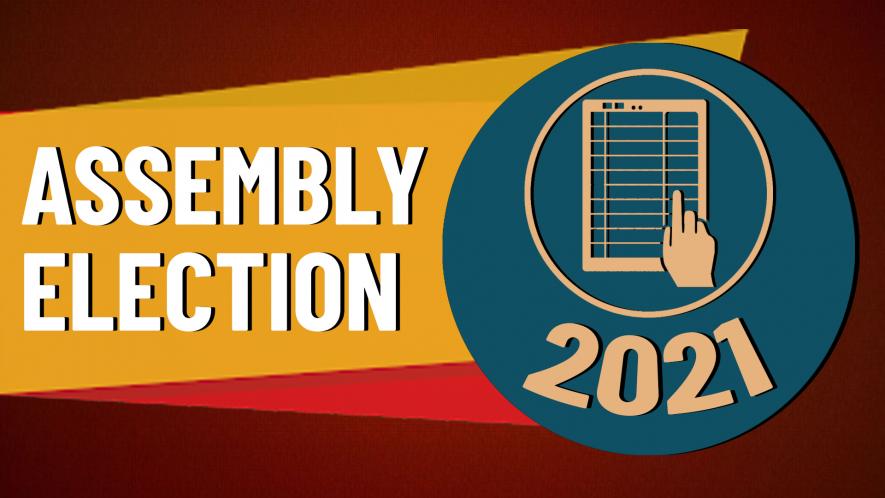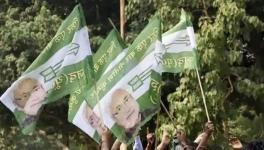Why IOU May be the X-factor in Assam Assembly Polls

With a day left to go for the third and final phase of Assam polls, much of the limelight has been hogged by the EVM controversy and the Election Commission's 48-hour ban (which was later reduced to 24 hours) on Assam’s Health Minister and forever CM-in-waiting, Himanta Biswa Sarma. Consequently, a startling statement by Sarma which would have sent shock waves, has gone unnoticed and under-reported.
On April 1, in an interview to a regional channel, Sarma stated that his saffron party had aided the creation of the newly-floated regional parties Assam Jatiya Parishad (AJP) and Raijor Dal to split the anti-CAA votes.
“We had encouraged the formation of AJP and let our party workers attend their meetings so that they feel they have takers. Whether it is AJP or Raijor Dal or any other party, they have been floated according to the BJP’s strategy. Although the CAA is not much of a factor, the idea behind creating the new regional parties was to split the votes of those against the law between them and the Congress and its allies,” Sarma was quoted as saying by the local channels.
The Index of Opposition Unity and Assam, the Outlier
Though India inherited its first-past-the-post system from Britain, Indian elections have been very different from the two-party contests in Britain. Historically, India has always had a dominant party along with many other opposition parties. As a result, the fragmented opposition has ended up aiding the dominant or the ruling party of the time. For instance, the Congress in the early days of India’s democracy and the BJP in recent times.
This division in Opposition votes gives an unfair advantage to the dominant or leading political party of the time in terms of seats won, as they manage to win a large number of seats with small margins. In other words, a small percentage of vote-share is enough to give it a huge majority.
Prannoy Roy and Ashok Kumar Lahiri in the 1980s developed the Index of Opposition Unity (IOU) to study the unity and disunity among Opposition parties and the expected ramifications of the changing patterns of opposition unity or disunity.
It is to be noted that the IOU is a definition and not an equation. The IOU which ranges from 0 to 100 is:
Vote (%) of the largest Opposition party
IOU= -------------------------------------------------------------- x 100
Sum of the votes (%) of all Opposition parties
The IOU works not just for the ruling party, but for whichever is the dominant electoral force in a state or region. The IOU, as stated earlier can vary from 0 to 100, with 100 implying that there is only one Opposition party i.e bi-party system. As the IOU falls down more and more- it signifies an increasingly divided or splintered Opposition.
Between 1952-1977, the average IOU (data analysed for 78 Assembly polls in big and medium-sized states) was 69. In the most recent phase (2002-2019) of India’s elections, called the fifty-fifty phase, by Prannoy Roy and Dorab Sopariwala in their book The Verdict: Decoding India’s Elections, the average IOU has fallen to 64.
The state of Assam has been an outlier. The average IOU in the state during 2002-2019 was 37, way below the national average of 64.
Table ‘A’ - Falling IOU over the years and Assam- the outlier
Source:The Verdict by Prannoy Roy and Dorab Sopariwala. | Only Assam: calculated using data from Indiavotes.com
How does the IOU matter? Does a lower or higher IOU significantly impact the mandate? And what has been the fallout of an abysmally lower IOU in Assam (from 2002-2019) for Opposition parties?
India’s first-past-the-post system combined with a lower IOU has resulted in seats being won by candidates who have secured less than 30% or 25% of the votes polled. The average winning-vote threshold in Assembly elections has sharply declined over the years. In 78 Assembly elections held in big and medium-sized states between 1952 to 1977, the average votes secured by the winning party/ alliance was 44%. This means, to win an election, a party or an alliance had to win (on average) 44% of the votes polled. Fifty years later, this number has dropped to 40%; the popular vote needed to win an Assembly election has thus fallen.
Also read: Punjab Farmers Prepare for Long Haul as Harvest Season Nears
Table ‘B’ Popular vote needed to win state Assembly elections has declined over time.
Source:The Verdict by Prannoy Roy and Dorab Sopariwala
To put it simply, the dramatic fall in the average winning-vote threshold is directly linked to the Index of Opposition Unity (IOU).
A falling IOU has also resulted in another major development in India’s electoral politics. In the salad days of India’s democracy, seats were being won by winning the popular vote i.e 50% of the votes polled. Now, seats are being won, not by winning the popular vote, but by dividing the opposition.
Between 1952-1977, 36% of the seats were won due to a low IOU i.e opposition being divided as against 64% seats which were won by winning the popular vote -- getting more than 50% of the votes cast. The situation has completely changed now. More seats (55%) are now won due to a lower IOU by ensuring the opposition is divided than due to a higher popular vote.
Not surprisingly, Assam which has had a lower IOU between 2002-2019 is a statistical outlier yet again.
During 2002-2019, Assam voted thrice to elect a state government -2006, 2011 and 2016. In these Assembly elections, 71% of seats were won because of a lower IOU -as against the national average of 45% during the same period. In only 29% of the seats, did the winning candidate secure more than 50% of the votes polled.
Table ‘C’ A comparison of victories due to high popular vote v/s victories due to a low IOU i.e divided opposition.
Source:The Verdict by Prannoy Roy and Dorab Sopariwala and Indiavotes.com
The falling IOU and the rising number of seats won because of a lower IOU/ divided opposition means that the best mantra to win an election is to 'Divide and Rule'. This principle of dividing the opposition to clinch seats- holds even greater significance in Assam due to its low IOU.
Perceiving the importance of ensuring a better IOU against the dominant BJP in a state where elections have been won and lost due to varying levels of IOU, the Congress was sensible in realising that its best chance of ousting the Sarbananda Sonowal led government was to unite all or most Opposition forces in the state. The formation of the Mahajot consisting of the Congress, All India United Democratic Front (AIUDF), Communist Party of India (CPI), CPI (Marxist), Bodo People's Front (BPF), Anchalik Gana Morcha (AGM) and Rashtriya Janat Dal (RJD) was thus a smart move.
However, if one goes by Sarma’s words, the BJP seems to have countered this move by propping up the regional front of AJP-Raijor Dal to divide the opposition to ensure its smooth sailing in the ensuing polls. The Congress had made several attempts to woo the newly formed regional parties to join its alliance, but all these attempts failed.
Despite the GOP’s best attempts, the regional combine of AJP-Raijor Dal, which is contesting separately, in all likelihood will hurt the prospects of the Mahajot. The AJP-Raijor Dal combine is not only expected to lower the IOU by splitting the anti-CAA votes, but there is also a possibility of the combine denting the minority vote-bank of the Congress and AIUDF. Anticipating this division of minority votes, the AIUDF chief Badruddin Ajmal recently lashed out at the newcomers accusing them of helping the BJP.
While conventional wisdom may suggest that the AJP-Raijor Dal combine may end up helping the BJP in a tightly contested election, on the flip slide, there is another possibility of the move backfiring and hurting the NDA, particularly, the AGP, which cannot be ruled out.
The AJP-Raijor alliance is being backed by the All Assam Students Union (AASU) and Asom Jatiytabadi Yuba Chatra Parishad (AJYCP), which spearheaded the anti-foreigner Assam agitation of 1979-85 and also played a pivotal role in founding the AGP. Thus, the AJP-Raijor coalition may also hurt the prospects of the NDA, cutting into the AGP’s base.
The author is a freelancer based in Bombay and an alumnus of Mumbai’s St. Xavier’s College. His interests vary from politics, psephology, and journalism to regional Indian cinema. He tweets @Omkarismunlimit
Get the latest reports & analysis with people's perspective on Protests, movements & deep analytical videos, discussions of the current affairs in your Telegram app. Subscribe to NewsClick's Telegram channel & get Real-Time updates on stories, as they get published on our website.























